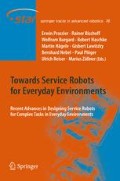Abstract
Interactive teaching is a coordinated activity in many different respects. This includes intra-personal aspects, like the joint production of speech and gestures, as well as inter-personal aspects, like the processing of verbal corrections while an action is performed. Given the experimental paradigm of human-robot interaction research, coordinated activities may be changed, added, or removed in an iterative manner. To keep the system maintainable despite coordination dependencies is an architectural challenge that is systematically analyzed in the following and supported by a toolkit. In many proposed robotic software architectures, coordination of active components that carry out tasks occurs through coupled statemachines that track the shared system state. This represents a generalizable software pattern that we have identified and analyzed in a general manner for the first time.
Furthermore, in mixed-initiative Human-Robot-Interaction, tasks can be initiated by either participant, causing the active and passive roles to change. Such changes have not been addressed before and we have generalized task coordination to encompass them. Last, but not least, distributed state tracking is complex, and previous implementations have thus often placed it entirely in a centralized coordination service that, however, increases coupling. Instead, we have developed a task service toolkit, which can be embedded in components, and demonstrated that this reduces component complexity considerably, without affecting coupling. Based on it, both centralized and de-centralized coordination services are possible.
Access this chapter
Tax calculation will be finalised at checkout
Purchases are for personal use only
Preview
Unable to display preview. Download preview PDF.
References
Brooks, R.: A robust layered control system for a mobile robot. IEEE Journal of Robotics and Automation 2(1), 14–23 (1986)
Chidamber, S.R., Kemerer, C.F.: A metrics suite for object oriented design. IEEE Transactions on Software Engineering 20(6), 476–493 (1994)
Gat, E.: Three-layer architectures. In: Kortenkamp, D., Bonasso, R.P., Murphy, R. (eds.) Artificial Intelligence and Mobile Robots, pp. 195–210. MIT Press, Cambridge (1998)
Hanheide, M., Sagerer, G.: Active memory-based interaction strategies for learning-enabling behaviors. In: International Symposium on Robot and Human Interactive Communication, RO-MAN, Munich (2008)
Kortenkamp, D., Simmons, R.: Robotic System Architectures and Programming, ch. 8, pp. 187–206. Springer (2008)
Lefebvre, D.R., Saridis, G.N.: A computer architecture for intelligent machines. In: Proceedings of IEEE International Conference on Robotics and Automation, vol. 3, pp. 2745–2750 (1992)
Lütkebohle, I.: Coordination and composition patterns in the “curious robot” scenario. PhD thesis, Bielefeld University (2010)
Lütkebohle, I., Peltason, J., Schillingmann, L., Elbrechter, C., Wrede, B., Wachsmuth, S., Haschke, R.: The Curious Robot - Structuring Interactive Robot Learning. In: International Conference on Robotics and Automation. IEEE (2009)
Lütkebohle, I., Philippsen, R., Pradeep, V., Marder-Eppstein, E., Wachsmuth, S.: Coordination and Control for Complex Robot Software Systems: The Task-State Pattern. Journal of Software Engineering for Robotics (submitted, 2011)
Marder-Eppstein, E., Pradeep, V.: ROS actionlib package documentation (2009), http://www.ros.org/wiki/actionlib
Mataric, M.J.: Integration of representation into goal-driven behavior-based robots. IEEE Transactions on Robotics and Automation 8(3), 304–312 (1992)
Nilsson, N.J.: Shakey the robot. Tech. rep., SRI International, Menlo Park, CA, USA (1984), collection of earlier reports
Plöger, P.G., Pervölz, K., Mies, C., Eyerich, P., Brenner, M., Nebel, B.: The desire service robotics initiative. KI Zeitschrift Künstliche Intelligenz 22(4), 29–32 (2008)
Runeson, P., Höst, M.: Guidelines for conducting and reporting case study research in software engineering. Empirical Software Engineering 14(2), 131–164 (2009)
Saridis, G.: Intelligent robotic control. IEEE Transactions on Automatic Control 28(5), 547–557 (1983)
Simmons, R., Apfelbaum, D.: A task description language for robot control. In: Proc. of Conference on Intelligent Robotics and Systems (1998)
Simmons, R.G.: Structured control for autonomous robots. IEEE Transactions on Robotics and Automation 10(1), 34–43 (1994)
Volpe, R., Nesnas, I., Estlin, T., Mutz, D., Petras, R., Das, H.: The claraty architecture for robotic autonomy. In: IEEE Proceedings Conference on Aerospace 2001, vol. 1, pp. 1/121–1/131 (2001)
Wrede, S., Hanheide, M., Wachsmuth, S., Sagerer, G.: Integration and coordination in a cognitive vision system. In: International Conference on Computer Vision Systems (ICVS). IEEE, St. Johns University (2006)
Author information
Authors and Affiliations
Corresponding author
Editor information
Editors and Affiliations
Rights and permissions
Copyright information
© 2012 Springer-Verlag GmbH Berlin Heidelberg
About this chapter
Cite this chapter
Lütkebohle, I., Wachsmuth, S. (2012). Task-Based Mixed-Initiative Coordination. In: Prassler, E., et al. Towards Service Robots for Everyday Environments. Springer Tracts in Advanced Robotics, vol 76. Springer, Berlin, Heidelberg. https://doi.org/10.1007/978-3-642-25116-0_32
Download citation
DOI: https://doi.org/10.1007/978-3-642-25116-0_32
Published:
Publisher Name: Springer, Berlin, Heidelberg
Print ISBN: 978-3-642-25115-3
Online ISBN: 978-3-642-25116-0
eBook Packages: EngineeringEngineering (R0)

